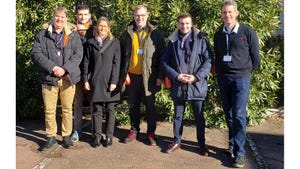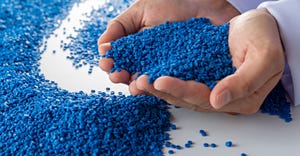Inline systems, food packaging drive Brown’s machines
The secret’s out: thermoforming is doing quite well in spite of the economy, and that is in part due to continued technology advancements, new energy efficient equipment, and new applications being converted from other processes. “Inline thermoforming and food packaging are booming, particularly with respect to barrier packaging for extended shelf life,” announced Jim Robbins, VP marketing for Brown Machine LLC (Beaverton, MI), during a press conference at the NPE tradeshow last month.
July 20, 2009
The secret’s out: thermoforming is doing quite well in spite of the economy, and that is in part due to continued technology advancements, new energy efficient equipment, and new applications being converted from other processes. “Inline thermoforming and food packaging are booming, particularly with respect to barrier packaging for extended shelf life,” announced Jim Robbins, VP marketing for Brown Machine LLC (Beaverton, MI), during a press conference at the NPE tradeshow last month. “Horticulture and medical packaging are also doing well. Polypropylene continues to expand in this market place.”
The Quad Series machines offer thermoformers even great precision. |
That’s the good news. The downside is heavy-gauge forming that cater to large, durable goods applications, and retail packaging, explained Robbins.
Brown had a lot to say at NPE. It introduced its Quad Series thermoformer, which it says comes fully equipped with a variety of premium features that raise the bar of performance capabilities and production. The cornerstone of this line is a new forming station that provides thermoformers more precise and consistent thermoformed product than previous systems, said the company. With up to 260 tons of holding force and 150 tons of coining force, the new forming station ensures virtually zero deflection— 3.5 thousandths of an inch— across the entire mold area. “Once you have closed the machine there is almost no deflection, so that material is not moving,” Robbins explained.
“This new design is to meet the market needs for PP and barrier products,” he said. “Currently there are five of these Quad Series machines in the field, one that is producing 250,000 lids/hour in a 50x60 forming bed with 132 cavities, for cups.” The Quad Series form station design (with patent pending features from Brown) combines continuous thermoforming technology with stamping (coining) technology to produce detailed parts quickly and consistently. The system is also available with Brown’s patented roller screw third-motion technology that improves material distribution, reduces starting gauges, and provides a greater process window. That results in better parts faster, and with less scrap material, said the company.
Robbins said, “This new machine puts Brown at an extreme competitive advantage. The deflection of 3.5 thousandths is unique and that’s key to quality and consistency.”
Each of the machine’s platens is driven by a servomotor “which is quite small,” noted Robbins. “The toggles are strategically positioned on a honeycomb platen, which also aids in eliminating deflection, and guarantees consistent material distribution across the complete mold area,” he said.
Brown Machine’s B-Series Hot Sheet thermoformer locates the sheet extruder closer to the thermoformer and integrates a roll stack within the B-line thermoformer. One of the major differences with established systems is that these Brown thermoformers incorporate a roll stack at the entrance end of the thermoformer, extruding the hot sheet material directly onto a set of conditioning rolls within the machine. This eliminates the need for a separate roll stand system, thereby reducing costs in both components and energy utilization. When extruding sheet directly into the back of the thermoformer, the material comes into the former at a hotter temperature, which is a significant advantage, explained Robbins. “This helps cut heater and energy costs by 25-35% and that’s the biggest advantage to this,” he said.
Brown also introduced tighter tolerance trimming with its new Servo Treadle option. In a typical trimming operation the treadle movement is tied mechanically to the movement of the moving platen within the thermoforming trim press. The formed parts are then carried into the die and piloted as the punch enters the die during final trim. Brown’s new Servo Treadle option separates the movement into two independent motions, allowing the punch to pilot into the product prior to entering the die. Precise piloting prior to entering the trim die ensures the highest levels of trip concentricity, said Brown.
Additionally, treadle speed is electronically matched to the press speed to ensure precise timing as the speed of the press is accelerated or decelerated. The treadle is guided on linear bearings and rails for more precise movement, and the linkage incorporates rod locks for quick release. This advanced treadle system can interface with either Brown servo flex or servo nip wheel feed systems.
Brown’s new treadle lift option facilitates faster trim press tool changeovers. “Customers asked for a reduced changeover time, which we can do with the treadle lift,” said Robbins. The new treadle lift system, incorporated within the treadle assembly, moves the sheet guides up and out of the way for tooling loading. The canopy is moved fore or aft providing clearance above the feed area, and the treadle will adjust upward on a cylinder-actuated guide system. With the sheet guides lifted out of the way, the die-set is easily rolled out of the side of the trip press for tool change. The new die-set is then installed, the treadle is lowered to operation height, and the press is back together and ready for production. “It represents the next evolution—the treadle lifts the die out,” Robbins said, adding that trim tool changeovers can be done more quickly, from 4-8 hours in 1988 to 1.5 hours in 2009 with centerline changes.
In thermoforming, explained Robbins, “as the machines get bigger and faster, the tooling gets bigger, faster and more complex to support it, so it’s critical to have bigger, faster, more precise trimming capabilities. We’ve got a machine in the field that has a four-row trim station on a 16 oz. coffee cup lid. They get eight rows of precise trimming at 90 cycles a minute.” —[email protected]
About the Author(s)
You May Also Like




